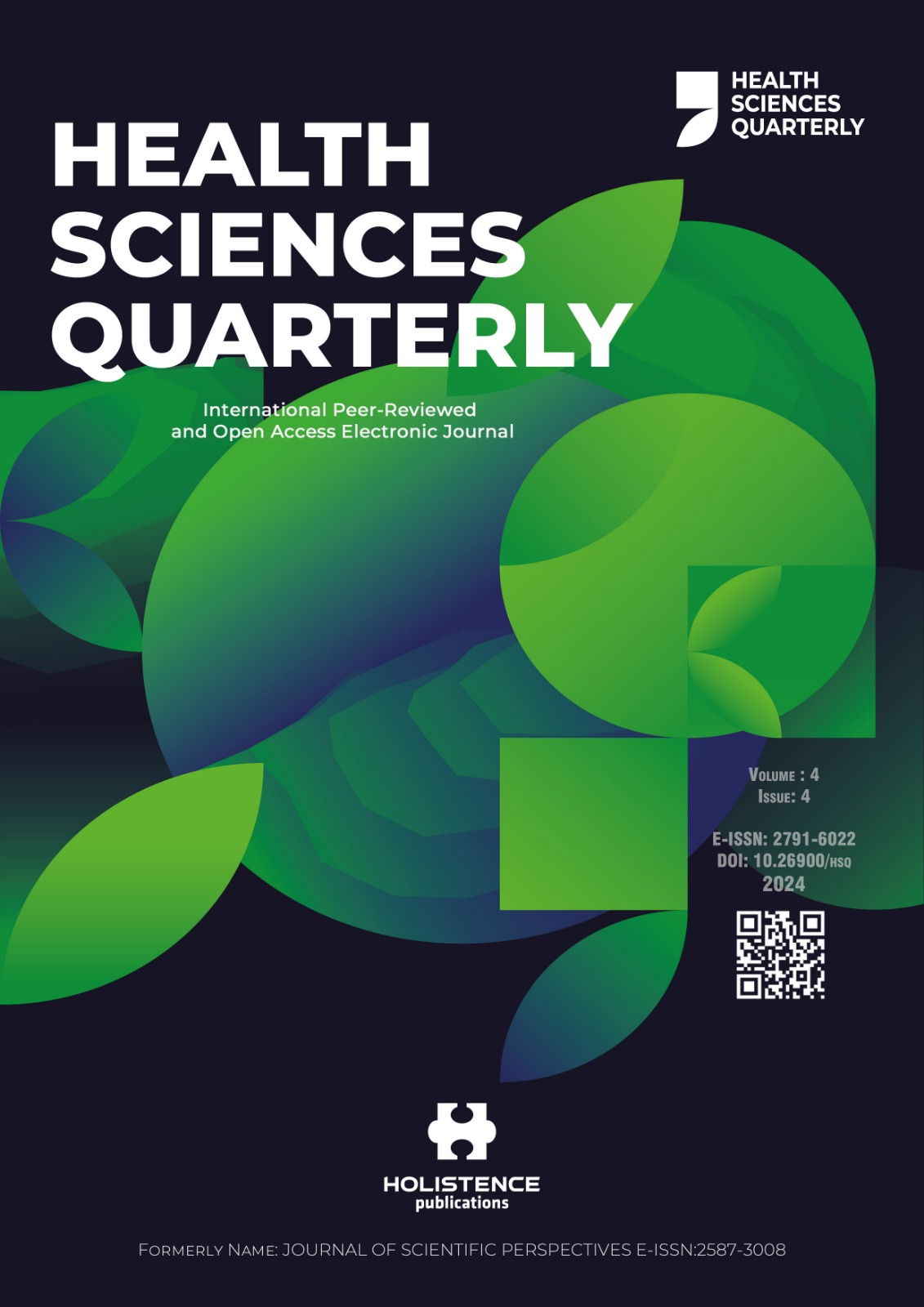The effect of environmental stressors perceived by surgical intensive care unit patients on hopelessness level
DOI:
https://doi.org/10.26900/hsq.2386Keywords:
Intensive care, environmental stressor, hopelessness, nurseAbstract
The aim of the research was to determine the effects of environmental stressors perceived by patients hospitalized in the surgical intensive care unit on hopelessness level. This descriptive research was performed between September 2023 and February 2024. The population of the study included all adult patients hospitalized in the Surgical Intensive Care Clinic of a City Hospital in Eastern Türkiye. The sample of the study includes 230 patients selected by random sampling method from this population. We used Personal Information Form, Intensive Care Unit Environmental Stressors Scale (ICUESS) and Beck Hopelessness Scale (BHS) to collect the data. Descriptive statistics, t-test, ANOVA, and correlation analysis tests were used to evaluate the data. The ICUESS mean score of the patients participated in the study was found to be at a high level with 102.13±15.95. Beck hopelessness scale score mean was found to be at a mild level with 6.36±5.78. It was found that the patients' gender, age, educational status, chronic disease status and previous intensive care experience affected the level of hopelessness. The relationship between ICUESS and BHS scores of the patients included in the study was examined and it was found that there was a low level of positive significant relationship between them (r: 0.162, p: 0.014). The hopelessness level of patients in surgical intensive care units was found to increase as the level of exposure to environmental stressors increased. It may be recommended to identify environmental stressors affecting the hopelessness level of patients and to implement interventions to reduce them.
Downloads
References
Ayhan D, Yılmaz D. The evaluation of the correlation between bricolage and innovativeness behaviors of intensive care nurses. Journal of Uludağ University Faculty of Medicine. 2022;48(2): 239-47. doi:10.32708/uutfd.1119934. DOI: https://doi.org/10.32708/uutfd.1119934
Tor Ö, Mert G, Tosun B. The effect of the positions assigned to intensive care patients on hemodynamic measurements. Dokuz Eylül University Faculty of Nursing Electronic Journal. 2019;12(1):15-20.
Bai J, Fügener A, Gönsch J, Brunner JO, Blobner M. Managing admission and discharge processes in intensive care units. Health Care Manag Sci. 2021;24(4):666-85. doi:10.1007/s10729-021-09560-6. DOI: https://doi.org/10.1007/s10729-021-09560-6
Kırşan M, Yıldırım D, Ceylan B, Korhan EA, Uyar M. Ethical problems in intensive care units: A systematic review. Türkiye Klinikleri Journal of Medical Ethics-History of Law. 2018;26(2):57-65. doi: 10.5336/mdethic.2018-59858. DOI: https://doi.org/10.5336/mdethic.2018-59858
Gültekin Y, Özçelik Z, Akıncı S, Yorgancı H. Evaluation of stressors in intensive care unit. Turkish Journal of Surgery. 2018;34:5-8. doi:10.5152/turkjsurg.2017.3736. DOI: https://doi.org/10.5152/turkjsurg.2017.3736
Zengin N, Ören B, Üstündağ H. The relationship between stressors and intensive care unit experiences. Nurs Crit Care. 2020;25(2):109-16. doi:10.1111/nicc.12465. DOI: https://doi.org/10.1111/nicc.12465
Dönmez YC, Korkmaz FD, Geçit S. Perception of environmental stressors in the intensive care unit by patients. Türkiye Klinikleri Journal of Nursing Sciences. 2020;12(2):190-7. doi: 10.5336/nurses.2019-72255. DOI: https://doi.org/10.5336/nurses.2019-72255
Şahin M, Köçkar Ç. Intensive care as a stressor. Journal of Psychology of Life Skills. 2018;2(4):207-14. doi:10.31461/ybpd.453981. DOI: https://doi.org/10.31461/ybpd.453981
Özdemir N, Saygı Ç. Nursing approach to anxiety seen in intensive care patients. International Journal on Mathematic, Engineering and Natural Sciences. 2019;9:23-31.
Avcı ŞY, Yılmaz D. Examining the level of collaboration among nurses working in intensive care units. Journal of Nursing Science. 2022;5(2):84-93. doi:10.54189/ hbd.1116121. DOI: https://doi.org/10.54189/hbd.1116121
Sekmen ID, Ünsar S. Determination of the experiences of patients treated in the intensive care unit. Journal of Cardiovascular Nursing. 2018;9(20):113-9. doi: 10.5543/khd.2019.20982. DOI: https://doi.org/10.5543/khd.2019.20982
Karadeniz FT, Kanan N. Environmental stressors affected by patients hospitalized in reanimation intensive care unit. Journal of Intensive Care Nursing. 2019;23(1):1-8.
Shdaifat SA, Al Qadire M. Anxiety and depression among patients admitted to intensive care. Nursing in Critical Care. 2022;27(1):106-12. doi:10.1111/nicc.12536. DOI: https://doi.org/10.1111/nicc.12536
Ravindran OS, Shankar A, Murthy T. A comparative study on perceived stress, coping, quality of life, and hopelessness between cancer patients and survivors. Indian J Palliat Care. 2019;25(3):414-20. doi: 10.4103/IJPC.IJPC_1_19. DOI: https://doi.org/10.4103/IJPC.IJPC_1_19
Dunn SL, Robbins LB, Tintle NL, et al. Heart up! RCT protocol to increase physical activity in cardiac patients who report hopelessness: Amended for the COVID-19 pandemic. Res Nurs Health. 2021;44(2):279-94. doi:10.1002/nur.22106. DOI: https://doi.org/10.1002/nur.22106
Fortuna KL, Venegas M, Bianco CL, Smith B, Batsis JA, Walker R, et al. The relationship between hopelessness and risk factors for early mortality in people with a lived experience of a serious mental illness. Soc Work Ment Health. 2020;18(4):369-82. doi:10.1080/15332985.2020.1751772. DOI: https://doi.org/10.1080/15332985.2020.1751772
Altun ÖŞ, Olçun Z. The concept of hope in schizophrenic patients. Journal of Health Sciences and Professions. 2018;5:107-12. doi:10.17681/hsp.292987. DOI: https://doi.org/10.17681/hsp.292987
Atan G, Özer Z, Turan GB. Assessment of hopelessness and spiritual care perception in cancer patients. Journal of Contemporary Medicine. 2020;10(2):266-74. doi: 10.16899/ jcm.649645. DOI: https://doi.org/10.16899/jcm.649645
Cohen J. Statistical Power Analysis for the Behavioral Sciences (2nd ed.). New York: Routledge; 1988. 567 p.
Ballard KS. Identification of environmental stressors for patients in a surgical intensive care unit. Issues in Mental Health Nursing. 1981:3(1-2);89-108. doi:10.3109/01612848109140863. DOI: https://doi.org/10.3109/01612848109140863
Cochran J, Ganong LH. A comparison of nurses' and patients' perceptions of intensive care unit stressors. J Adv Nurs. 1989;14(12):1038-43. doi:10.1111/j.1365-2648.1989.tb01515.x. DOI: https://doi.org/10.1111/j.1365-2648.1989.tb01515.x
Aslan F. Environmental stressors perceived by patients treated in the intensive care unit: Validity and reliability study. [in Turkish]. Master's Thesis. Marmara University. İstanbul. 2010.
Beck AT, Weissman A, Lester D, Trexler L. The measurement of pessimism: The hopelessness scale. J Consult Clin Psychol. 1974;42(6):861-5. doi: 10.1037/h0037562. DOI: https://doi.org/10.1037/h0037562
Seber G, Dilbaz N, Kaptanoglu C, Tekin D. The hopelessness scale: Validity and reliability. Kriz Dergisi. 1993;1(3):139-42.
Durak A. Palabıyıkoğlu R. The beck hopelessness scale validity study. Kriz Dergisi. 1994;2(2): 311-9. DOI: https://doi.org/10.1501/Kriz_0000000071
Karagöz Y. SPSS and AMOS applied quantitative-qualitative-mixed scientific research methods and publication ethics. 1st Edition. Ankara: Nobel Academic Publishing; 2017.
Gencer A, Kumsar AK. The effect of environmental stressors perceived by patients treated in the intensive care unit on sleep quality. Online Turkish Journal of Health Sciences. 2020;5(3):434-43. DOI: https://doi.org/10.26453/otjhs.694088
Barros JKA, Siuves A. Stressors in intensive care units: strategies for humanization of care. Hospice Palliative Medicine International Journal. 2018;2(6):378-84. DOI: https://doi.org/10.15406/hpmij.2018.02.00129
Madani H, Pourmemari M, Moghimi M, Rashvand F. Hopelessness, perceive social support and their relationship in Iranian patients with cancer. Asia-Pac j Oncol Nurs. 2018;5(3):314-9. 33. doi: 10.4103/apjon.apjon_5_18. DOI: https://doi.org/10.4103/apjon.apjon_5_18
Karakaş N, Büyükbayram Z, Aktura SÇ, Evren B, Sarıtaş SÇ. Investigation of the relationship between social support and hopelessness levels in diabetic patients: Descriptive research. Journal of Gümüşhane University Health Sciences. 2023;12(2):757-63. doi: 10.37989/gumussagbil.1227001. DOI: https://doi.org/10.37989/gumussagbil.1227001
Budak FK, Özdemir A, Gültekin A, Ayhan MO, Kavak M. The effect of religious belief on depression and hopelessness in advanced cancer patients. J Relig Health. 2021;60(4):2745-55. doi: 10.1007/s10943-020-01120-6. DOI: https://doi.org/10.1007/s10943-020-01120-6
Koyuncu F, Şahin SY, İyigün E. Investigation of the effect of perceived environmental stressors on sleeping patterns of patients treated in the general surgical intensive care unit. Journal of Intensive Care Nursing. 2021;25(3):152-9.
Aktaş Y, Karabulut N, Yılmaz D, Özkan A. Perception of environmental stressors by critical care patients treated in cardiovascular surgery intensive care unit. Kafkas J Med. Sci. 2015;5:81-6. doi: 10.5505/kjms.2015.29591. DOI: https://doi.org/10.5505/kjms.2015.29591
Berber E, Kızıltan B. Determination of environmental stressors perceived by patients treated in the cardiovascular surgery intensive care unit. Turk J Cardiovasc Nurs. 2022;13(31):91-8. doi: 10.5543/khd.2022.211422. DOI: https://doi.org/10.5543/khd.2022.211422
Zaybak A, Çevik K. Perception of stressors in the intensive care unit by patients and nurses. Intensive Care Journal. 2015;6:4-9. doi: 10.5152/dcbybd.2015.652. DOI: https://doi.org/10.5152/dcbybd.2015.652
Taşan N, Sarıtaş SÇ. The relationship between spirituality and hopelessness among cancer patients in Turkey. J Relig Health. 2022;61(2):1376-89. doi: 10.1007/s10943-021-01470-9. DOI: https://doi.org/10.1007/s10943-021-01470-9
Salık S, Sarıtaş SÇ. Determination of quality of life and hopelessness levels in patients with heart failure. Journal of Cardiovascular Nursing. 2021;12(29):173-82. doi: 10.5543/khd.2021.51523. DOI: https://doi.org/10.5543/khd.2021.51523
Downloads
Published
How to Cite
Issue
Section
License
Copyright (c) 2024 Holistence Publications

This work is licensed under a Creative Commons Attribution 4.0 International License.
When the article is accepted for publication in the HSQ authors transfer all copyright in the article to the Holistence Academy Ar-Ge Yazılım Yayıncılık Eğitim Danışmanlık ve Organizasyon Ticaret Ltd. Şti.The authors reserve all proprietary right other than copyright, such as patent rights.
Everyone who is listed as an author in this article should have made a substantial, direct, intellectual contribution to the work and should take public responsibility for it.
This paper contains works that have not previously published or not under consideration for publication in other journals.















